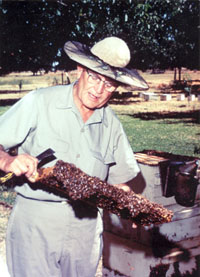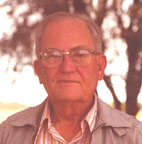
Harry H. Laidlaw Jr. (1907-2003)
Harry Hyde Laidlaw Jr. (1907-2003)
Father of Honey Bee Genetics
Bee biologist Harry Hyde Laidlaw Jr. (1907-2003), known as “the father of honey bee genetics,” served on the UC Davis Department of Entomology faculty from 1947 until his retirement in 1974. Long after his retirement, however, the professor continued his research and outreach programs, publishing his last scientific paper at age 87 and his last book at 90. He died at age 96 at his home in Davis.
Childhood and Career Development
Born April 12, 1907 in Houston, Harry spent his boyhood and teen years in the Southeast: Virginia, Florida and Louisiana. In his childhood, he developed a keen interest in bee breeding and worked with his grandfather, Charles Quinn. They experimented with mating queen bees and control breeding and developed what became known as the Quinn-Laidlaw hand-mating method.
 In 1929, while working in Baton Rouge, Laidlaw was encouraged by his boss to attend Louisiana State University. He completed his master's degree in entomology in 1934 from Louisiana State University and received his doctorate in genetics and entomology form the University of Wisconsin in 1939. Two years later he was inducted into the U.S. Army, commissioned. and served as the Army entomologist for the First Service Command in Boston. There he met Ruth Collins, whom he married in 1946. They lived in New York City where he worked as a civilian entomologist for the Army. His career with the UC Davis Department of Entomology began in 1947.
In 1929, while working in Baton Rouge, Laidlaw was encouraged by his boss to attend Louisiana State University. He completed his master's degree in entomology in 1934 from Louisiana State University and received his doctorate in genetics and entomology form the University of Wisconsin in 1939. Two years later he was inducted into the U.S. Army, commissioned. and served as the Army entomologist for the First Service Command in Boston. There he met Ruth Collins, whom he married in 1946. They lived in New York City where he worked as a civilian entomologist for the Army. His career with the UC Davis Department of Entomology began in 1947.
 Laidlaw is best known for developing artificial insemination technology for honey bees. His contributions enabled selective breeding of honey bees and pioneered the fundamental study of insect genetics. He authored numerous scientific publications and four books on honey bee genetics and breeding.
Laidlaw is best known for developing artificial insemination technology for honey bees. His contributions enabled selective breeding of honey bees and pioneered the fundamental study of insect genetics. He authored numerous scientific publications and four books on honey bee genetics and breeding.
Laidlaw studied pests and diseases and conducted research on the breeding of queen bees and on re-queening bee colonies. His research on artificial insemination of bees inspired poet E.B. White to write a poem, "Song of the Queen Bee," published in the New Yorker magazine in 1945. It included the lines “What boots it to improve a bee, if it means an end to ecstasy.”
International Awards
Laidlaw received national and international awards for his research and service to the university, agriculture and the beekeeping industry. He was elected a fellow of the American Association for the Advancement of Science in 1955, and the Entomological Society of America (ESA) in 1991. At UC Davis, he was the first associate dean for research (1969) in the College of Agricultural and Environmental Sciences. The College of Ag selected him for its Award of Distinction in 1997.
Laidlaw was awarded the Western Apiculture Society's "Outstanding Service to Beekeeping" award in 1980, being cited as "one of the great scientists in American agriculture." In 1981 he won the C.W. Woodworth Award of the Pacific Branch of the ESA.
Laidlaw published his classic text Queen Rearing in 1950, in collaboration with J. E. Eckert. He published his last book, Queen Rearing and Bee Breeding, written in collaboration with Robert Page, former chair of the UC Davis Department of Entomology, in 1997
Although retired, in 1980-85, he established a honey bee breeding program for the Egyptian Ministry of Agriculture as part of a joint UC-Egypt agricultural development program.
Naming of Laidlaw Facility
In 2001, the Bee Biology Laboratory at UC Davis was renamed the Harry H. Laidlaw Jr. Honey Bee Research Facility. Local artist and sculptor Donna Billick and entomologist-artist Diane Ullman designed the sign at the facility.
Harry H. Laidlaw Papers from the UC Davis Special Collections
Biographical materials, correspondence, writings, research materials, course materials, printed materials, memorabilia, photographs.
(Sources: Robert E. Page Jr.; Harry Laidlaw's daughter Barbara Murphy; and the UC Davis Special Collections)